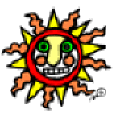En
español 
Classroom website
En
español |
|
It is modern art's most powerful antiwar statement... created by the twentieth century's most well-known and least understood artist. But the mural called Guernica is not at all what Pablo Picasso has in mind when he agrees to paint the centerpiece for the Spanish Pavilion of the 1937 World's Fair.
Hoping for a bold visual protest to Franco's
treachery from Spain's most eminent artist, colleagues and representatives of
the democratic government have come to Picasso's home in Paris to ask him to
paint the mural. Though his sympathies clearly lie with the new Republic,
Picasso generally avoids politics - and disdains overtly political art. The official theme of the Paris Exposition is a celebration of modern technology. Organizers hope this vision of a bright future will jolt the nations out of the economic depression and social unrest of the thirties.
On April 27th, 1937, unprecedented atrocities are perpetrated on behalf of Franco against the civilian population of a little Basque village in northern Spain. Chosen for bombing practice by Hitler's burgeoning war machine, the hamlet is pounded with high-explosive and incendiary bombs for over three hours. Townspeople are cut down as they run from the crumbling buildings. Guernica burns for three days. Sixteen hundred civilians are killed or wounded. By May 1st, news of the massacre at Guernica reaches Paris, where more than a million protesters flood the streets to voice their outrage in the largest May Day demonstration the city has ever seen. Eyewitness reports fill the front pages of Paris papers. Picasso is stunned by the stark black and white photographs. Appalled and enraged, Picasso rushes through the crowded streets to his studio, where he quickly sketches the first images for the mural he will call Guernica. His search for inspiration is over. This information comes from: |
¡Gracias por su
visita! home |